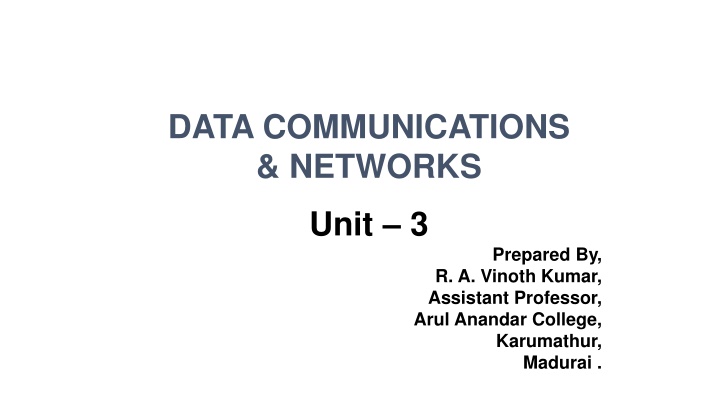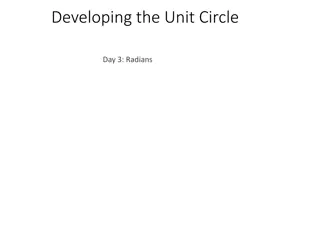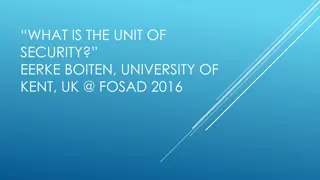
Errors and Error Detection Techniques in Data Communications and Networks
Explore the concept of errors in data communications and networks, including types of errors like single-bit and burst errors. Learn about error detection techniques such as parity check and checksum to ensure data integrity. Dive into the world of error prevention in the realm of data transmission.
Uploaded on | 1 Views
Download Presentation

Please find below an Image/Link to download the presentation.
The content on the website is provided AS IS for your information and personal use only. It may not be sold, licensed, or shared on other websites without obtaining consent from the author. If you encounter any issues during the download, it is possible that the publisher has removed the file from their server.
You are allowed to download the files provided on this website for personal or commercial use, subject to the condition that they are used lawfully. All files are the property of their respective owners.
The content on the website is provided AS IS for your information and personal use only. It may not be sold, licensed, or shared on other websites without obtaining consent from the author.
E N D
Presentation Transcript
DATA COMMUNICATIONS & NETWORKS Unit 3 Prepared By, R. A. Vinoth Kumar, Assistant Professor, Arul Anandar College, Karumathur, Madurai .
Errors What is an Error? or a consequence of a particular action, operation, or course, is known as error. Error or mistake leads to a defect and usually raises due to various reasons. It may be system specification issue or design issue or coding issue, which leads to a defect. Error leads to defects and if the defect uncovered by QA leads to Failure. When the system produces an outcome, which is not the expected one There are three types of errors in programming: (a) Syntax Errors, (b) Runtime Errors, and (c) Logical Errors.
Types Of Errors Single-Bit Error does not appear more likely in Serial Data Transmission. For example, Sender sends the data at 10 Mbps, this means that the bit lasts only for 1 ?s and for a single-bit error to occurred, a noise must be more than 1?s
Burst Error: The two or more bits are changed from 0 to 1 or from 1 to 0 is known as Burst Error. The Burst Error is determined from the first corrupted bit to the last corrupted bit. The duration of noise in Burst Error is more than the duration of noise in Single-Bit. Burst Errors are most likely to occurr in Serial Data Transmission. The number of affected bits depends on the duration of the noise and data rate.
Error Detecting Techniques: The most popular Error Detecting Techniques are: Single parity check Two-dimensional parity check Checksum Cyclic redundancy check Vertical Redundancy Check
Parity Check Single Parity checking is the simple mechanism and inexpensive to detect the errors. In this technique, a redundant bit is also known as a parity bit which is appended at the end of the data unit so that the number of 1s becomes even. Therefore, the total number of transmitted bits would be 9 bits. If the number of 1s bits is odd, then parity bit 1 is appended and if the number of 1s bits is even, then parity bit 0 is appended at the end of the data unit. At the receiving end, the parity bit is calculated from the received data bits and compared with the received parity bit. This technique generates the total number of 1s even, so it is known as even-parity checking.
Checksum A Checksum is an error detection technique based on the concept of redundancy. It is divided into two parts: Checksum Generator A Checksum is generated at the sending side. Checksum generator subdivides the data into equal segments of n bits each, and all these segments are added together by using one's complement arithmetic.The sum is complemented and appended to the original data, known as checksum field. The extended data is transmitted across the network. Suppose L is the total sum of the data segments, then the checksum would be ?L Cyclic Redundancy Check (CRC) CRC is a redundancy error technique used to determine the error.
steps used in CRC for error detection: In CRC technique, a string of n 0s is appended to the data unit, and this n number is less than the number of bits in a predetermined number, known as division which is n+1 bits. Secondly, the newly extended data is divided by a divisor using a process is known as binary division. The remainder generated from this division is known as CRC remainder. Thirdly, the CRC remainder replaces the appended 0s at the end of the original data. This newly generated unit is sent to the receiver. The receiver receives the data followed by the CRC remainder. The receiver will treat this whole unit as a single unit, and it is divided by the same divisor that was used to find the CRC remainder. If the resultant of this division is zero which means that it has no error, and the data is accepted. If the resultant of this division is not zero which means that the data consists of an error. Therefore, the data is discarded.
Vertical Redundancy Check It is also known as Parity Check. In this method, a redundant bit also called parity bit is added to each data unit. This method includes even parity and odd parity. Even parity means the total number of 1s in data is to be even and odd parity means the total number of 1s in data is to be odd.
Error Correction Error Correction codes are used to detect and correct the errors when data is transmitted from the sender to the receiver. Error Correction can be handled in two ways: Backward error correction: Once the error is discovered, the receiver requests the sender to retransmit the entire data unit. Forward error correction: In this case, the receiver uses the error-correcting code which automatically corrects the errors. A single additional bit can detect the error, but cannot correct it.






















